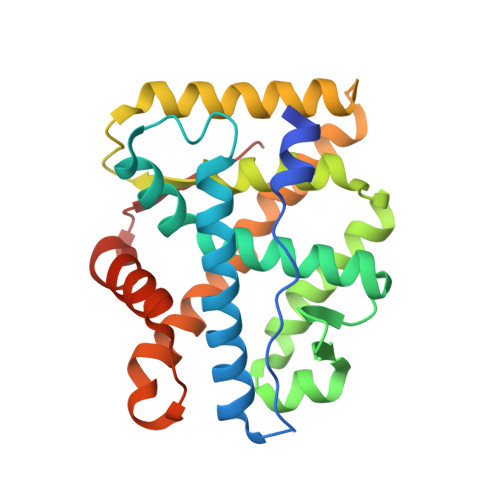Structural basis of spirolactone recognition by the mineralocorticoid receptor
Huyet, J., Pinon, G.M., Fay, M.R., Fagart, J., Rafestin-Oblin, M.E.(2007) Mol Pharmacol 72: 563-571
- PubMed: 17569793
- DOI: https://doi.org/10.1124/mol.107.036459
- Primary Citation of Related Structures:
2OAX - PubMed Abstract:
Spirolactones are potent antagonists of the mineralocorticoid receptor (MR), a ligand-induced transcription factor belonging to the nuclear receptor superfamily. Spirolactones are synthetic molecules characterized by the presence of a C17 gamma-lactone, which is responsible for their antagonist character. They harbor various substituents at several positions of the steroid skeleton that modulate their potency in ways that remain to be determined. This is particularly obvious for C7 substituents. The instability of antagonist-MR complexes makes them difficult to crystallize. We took advantage of the S810L activating mutation in MR (MR(S810L)), which increases the stability of ligand-MR complexes to crystallize the ligand-binding domain (LBD) of MR(S810L) associated with 7alpha-acetylthio-17beta-hydroxy-3-oxopregn-4-en-21-carboxylic acid gamma-lactone (SC9420), a spirolactone with a C7 thioacetyl group. The crystal structure makes it possible to identify the contacts between SC9420 and MR and to elucidate the role of Met852 in the mode of accommodation of the C7 substituent of SC9420. The transactivation activities of MR(S810L/Q776A), MR(S810L/R817A), and MR(S810L/N770A) reveal that the contacts between SC9420 and the Gln776 and Arg817 residues are crucial to maintaining MR(S810L) in its active state, whereas the contact between SC9420 and the Asn770 residue contributes only to the high affinity of SC9420 for MR. Moreover, docking experiments with other C7-substituted spirolactones revealed that the MR(S810L)-activating potency of spirolactones is linked to the ability of their C7 substituent to be accommodated in LBD. It is remarkable that the MR(S810L)-activating and MR(WT)-inactivating potencies of the C7-substituted spirolactones follow the same order, suggesting that the C7 substituent is accommodated in the same way in MR(S810L) and MR(WT). Thus, the MR(S810L) structure may provide a powerful tool for designing new, more effective, MR antagonists.
Organizational Affiliation:
INSERM U773, Centre de Recherche Biomédicale Bichat-Beaujon, Paris, France.















